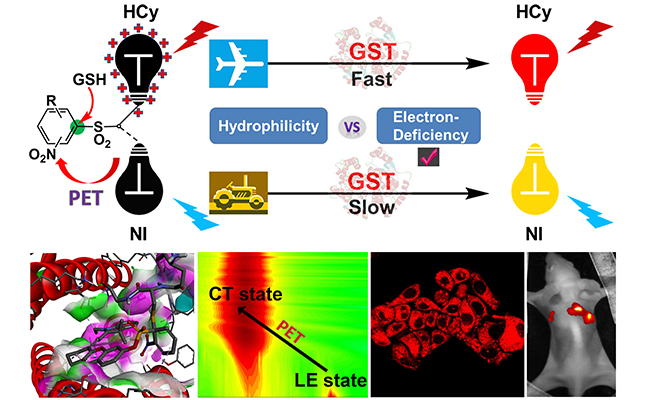Glutathione S-transferases (GST) are one of the most important phase II detoxification enzymes. It achieves detoxification by catalyzing the nucleophilic attack of glutathione (GSH) on the electrophilic center of the target substrate, increasing its hydrophilicity to facilitate its transportation and exocytosis.
Compared with the normal counterparts, GST is frequently overexpressed in various cancers, and is thus regarded as a significant marker for multidrug resistant cancers. By virtue of their deeper penetration, lower background fluorescence, and convenient in vivo imaging, near-infrared (NIR) fluorescent probes exhibit higher practicability.
Recently, Prof. HAN Keli's group and Prof. PIAO Hailong's group from the Dalian Institute of Chemical Physics (DICP) of the Chinese Academy of Sciences and their collaborators found that the holistic recognition performance of a fluorescent probe for GST was not only regulated by the recognition unit in the traditional meaning, but was also closely related to the eletron-deficiency of the fluorophore.
This study was published in Chemical Science on Sep. 21.

Fluorophore's electron-deficiency could affect the recognition performance of near-infrared fluorescent probes (Image by ZHANG Xuexiang)
The scientists introduced the NIR fluorophore HCy with a positive charge to replace the original two-photon fluorophore NI with the series of recognition units unchanged. They found that all HCy-based probes displayed stronger reactivity than the corresponding NI-based ones.
"We believed this phenomenon stemmed from the fluorophore's higher electron-deficiency other than its higher hydrophilicity," said Prof. HAN.
The resultant practical probes in HCy-series were those with weaker electron-withdrawing recognition units when comparing to NI3, which endowed the position 4 with a stronger –CN. This overturned –CN as the master key for all practical GST probes in previous literature.
Meanwhile, under the "signal amplifying" effect of this phenomenon, the selectivity distinction towards various GST isoenzymes triggered by the reactivity difference of the receptor units now could be distinguished. Subsequent imaging results in cells, tissues and living mice confirmed HCy2 and HCy9's practicality for detecting GST.
Additionally, although the fluorescent sensing of NIR probes was regarded as hard to modulate by photo-induced electron transfer (PET), researchers proved that the sensing mechanism for HCy-based probes is indeed PET, and the eletrophilicity would also in turn affect the efficiency of fluorescent sensing.
This work provides a beneficial inspiration and reference for designing fluorescent probes comprehensively.
It was supported by the National Natural Science Foundation of China, and the National Key Research and Development Program of China. (Text by ZHANG Xuexiang)